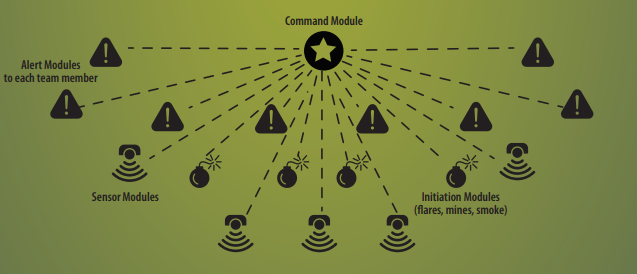How it does it
The C2Kit is a small, discrete, flexible system that can be carried by combat teams and deployed to provide dominance of the immediate battle space.The C2Kit provides command and control by linking monitoring of remote sensors with the ability to send simple signals to and from team members and to trigger deployed devices.
Who uses it
The C2Kit is designed for platoons, patrols, observation posts, forward observers, snipers, specialist teams, and other small combat team elements.The flexibility of the system means it can be deployed for ambushes, surveillance, platoon-in-defense, perimeter security, sniper, OP, and FOO protection.
How it is used
The commander can select elements of the C2Kit related to the mission.In location, sensors can be deployed and linked via the Sensor Modules to the Control Module. Flares, mines and other devices can be positioned and linked back to the Control Module via Initiation Modules and sentries and other team members are issued with Alert Modules so they can alert the commander of activity and the commander can send pre-programmed orders to the team members.
The integrated C2Kit provides greater command and control for the small combat team commander.
The C2Kit consists of:
The Control Module: Used by the commander to receive input from sensors and team members and to trigger devices.
Alert Modules: Used by soldiers to alert the commander of activity within their arc and for the commander to issue pre-programmed alerts and orders to the soldiers.
Input Output Module can be programmed as either a Sensor or Initiation Module,
Sensor Modules: Transmit information to the commander from deployed sensors.
Initiation Modules: Activated from the Control Module, trigger deployed devices such as flares, mines, lights, and remote weapons.
Programming Module: Links the selected modules and programs the Input/Output modules as Sensor or Initiation modules.
The loadout configuration can be modified to meet the needs of the team’s task.
The system is based on low-power (~40 milliwatts) using an established RF technology. The low power and the deliberate short range of ~250m provide coverage of the immediate battle space while retaining low detectability.
